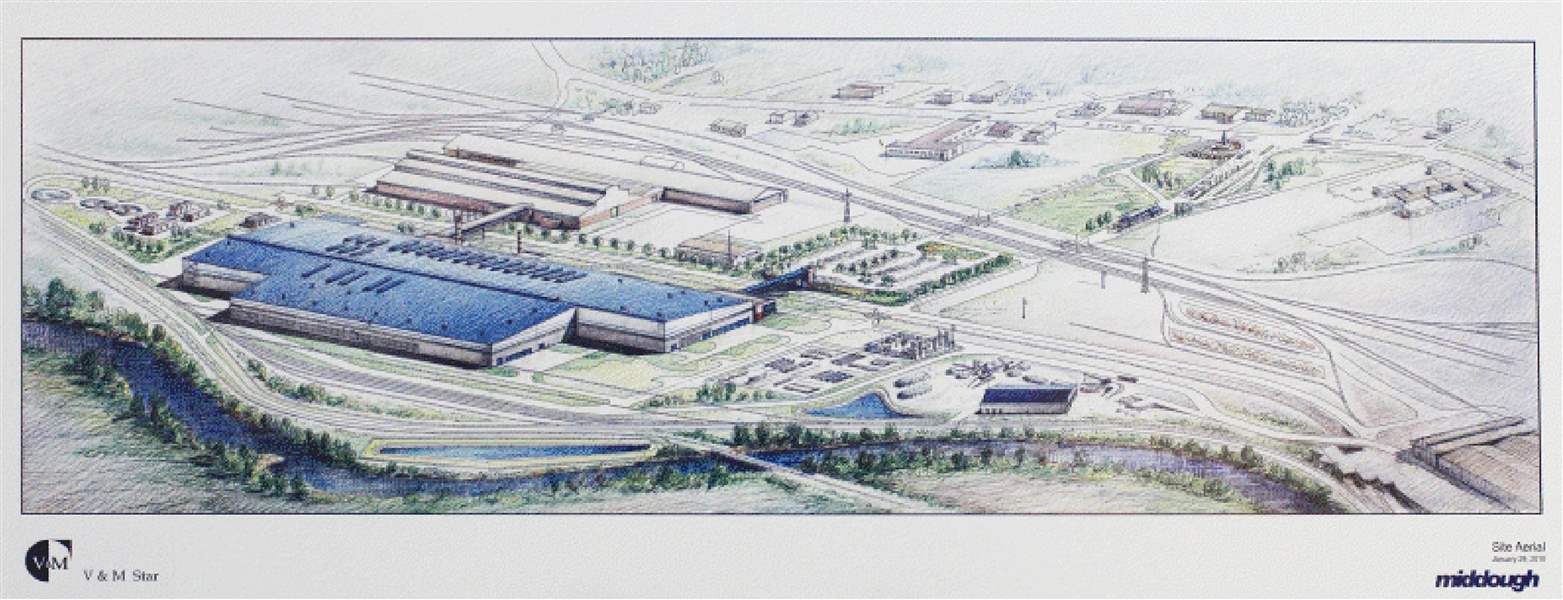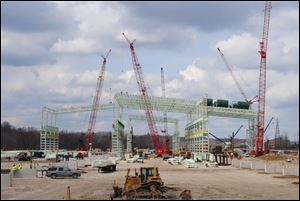
$650 million plant to transform Youngstown
Steel mill, expected to bring 350 jobs, atop natural-gas fields
4/19/2011
This artist's rendering shows V&M Star's new mill upon completion. Some 10 cranes are now at work, and the project has created and sustained hundreds of construction jobs. Youngstown Mayor Jay Williams says, 'We believe that [the city's industrial] corridor is going to be ripe for additional investment.'

The steel skeleton of the new V&M Star rolling mill takes shape in Youngstown. The plant's construction next to its existing operation is expected to more than double the mill's work force.
YOUNGSTOWN -- What's left of Youngstown's once redoubtable industrial corridor follows the Mahoning River through the valley that the water carved. Lording above those industrial relics -- above the still-active fabricating plants and tool-and-die shops -- is V&M Star. The city has pinned its financial hopes to the hulking mill works, which has pinned its own hopes upon the gaseous and liquid gold locked a mile underground.
Early in 2010, V&M Star announced it would build a $650 million rolling mill next to its existing Youngstown operation. It was the biggest private investment announced in all of Ohio that year, the biggest in that region since General Motors Co. built the Lords- town, Ohio, assembly plant nearly four decades ago, and the biggest in Youngstown in half a century, if not ever.
Today, the steel skeleton of the new plant is being erected by no fewer than 10 construction cranes.
The assembly has created or sustained hundreds of construction jobs, and the mill's operation will create 350 jobs by the end of 2012, more than doubling V&M's local work force.
A V&M melt shop, where raw steel is produced by melting scrap in furnaces, could be the next big project at that site. A complex that size, with two fabricating plants and the melt shop, could support ancillary and spin-off businesses, city fathers hope, from truck shops to hot dog stands.
"We believe that corridor is going to be ripe for additional investment," Youngstown Mayor Jay Williams said.
But why this corridor, instead of one in Oklahoma or Texas (where V&M Star's U.S. operations are headquartered), or even overseas, where V&M's French parent company, Vallourec, is based?
Because of what V&M will be making at its new, million-square-foot plant: small-diameter steel pipes, the kind used in transporting natural gas from well sites to compression stations and main lines.
Youngstown -- halfway between Cleveland and Pittsburgh, at 41.09 degrees north latitude and 80.65 west longitude -- is geographically positioned on top of both the Marcellus and Utica shales, two rock formations that hold untold reserves of natural gas and liquid hydrocarbons.
To the east, energy companies already have drilled hundreds of wells into the Marcellus Shale. To the west, major drillers such as Chesapeake Energy already have dug test wells into the deeper Utica Shale, with promising results.
Proximity to V&M's existing plant -- and to Youngstown's work force and "center of competency" -- was the main driver behind the company's decision to build in Youngstown, said Vince Bevacqua, spokesman for V&M Star. Proximity to the shale fields was the next reason on the list, and might turn out to be the most important one.
![v-M-star-new-mill.jpg This artist's rendering shows V&M Star's new mill upon completion. Some 10 cranes are now at work, and the project has created and sustained hundreds of construction jobs. Youngstown Mayor Jay Williams says, 'We believe that [the city's industrial] corridor is going to be ripe for additional investment.'](/image/2011/04/19/300x_b1a4-3_cCM_cT/v-M-star-new-mill.jpg)
This artist's rendering shows V&M Star's new mill upon completion. Some 10 cranes are now at work, and the project has created and sustained hundreds of construction jobs. Youngstown Mayor Jay Williams says, 'We believe that [the city's industrial] corridor is going to be ripe for additional investment.'
"Now it just seems so fortuitous," Mr. Bevacqua said. "Marcellus was the original target" three years ago, when expansion talks began.
"But now everybody is talking about the Utica."
V&M approached Youngstown business and government officials in 2008; the negotiations that ensued (dubbed "Operation Tomahawk," for reasons that nobody can remember) also involved state officials and those from a Youngstown suburb to the northwest, Girard, because the land on which V&M is now building its rolling mill was in Girard before being annexed by Youngstown.
"Have you seen the parking lots filled with construction cars?" asked Girard Mayor James Melfi. The mayor, like many in his town, comes from a mill family: His grandfather worked in a steel mill for 50 years, his dad for 33, his uncle for 20-plus, and Mr. Melfi did too for a few summers.
"I never would have thought we would see a new steel mill -- ever, from the ground up -- built in our region again," he said.
The deep-gas drilling energy boom in Western Pennsylvania means that "the market is here. … We were in the right place, at the right time, for once."
For many decades, the opposite has been true -- wrong place, wrong time.
Like the rest of the Rust Belt's, Youngstown's fortunes turned in the 1970s and 1980s as steel declined domestically. The Sept. 19, 1977, announcement that one of the city's Youngstown Sheet & Tube Co. mills (the Campbell Works, three miles southeast of downtown Youngstown) would be closing is still remembered by some as "Black Monday."

Youngstown Sheet & Tube, once one of the nation's top steel producers, was dismantled in 1977, but its legacy -- and its physical presence -- still affect this city. The company operated several mills in the region, and one of them is now occupied by V&M.
That mill was originally built by the Brier Hill Steel Co., which in 1923 was acquired by Youngstown Sheet & Tube. Then as now, the mill was a manufacturer of seamless pipes for the oil and gas industry, which was burgeoning locally at the outset of the 20th century, just as it is today, thanks to the Marcellus Shale gas reserves.
The mill, known as the Brier Hill Works when it was owned by Youngstown Sheet & Tube, was sold to Jones and Laughlin Steel, which later begat LTV. LTV closed the mill in 1979.
Eventually, Cargill International's North Star Steel Co. reopened the plant in the late 1980s; the following decade the plant changed hands again, when Cargill exited the metals business to concentrate on agriculture. In 2002, North Star Steel sold to Vallourec & Mannesmann (which is where the name V&M comes from).
But for all the changes in ownership, the old mill (and, soon, the new, unfinished one) puts out the same product today that it did a century ago. The difference now, said David Bozanich, Youngstown's finance director, is that the mill work is being done not just by brawny roughnecks but also by engineering graduates from Youngstown State University.
"Most of those jobs average in excess of $80,000 year," Mr. Bozanich said.
City leaders recognize Youngstown and the rest of the "Steel Valley" will never again be the manufacturing powerhouse it was in the mid-1900s. But they hope regional gas drilling can provide solid manufacturing jobs in the interim, while the Mahoning Valley -- with its 12 and 13 percent unemployment rates -- figures out what to become next.
So far, so good.
Nine miles north of Youngstown, in Brookfield, near the Pennsylvania border, pipe manufacturer TMK IPSCO is occupying a former Sharon Tube mill, and since spring 2010 has been manufacturing tube connections and fittings used in the oil and gas industry. Last month, the same plant announced it was installing a new thread line, allowing it to put out more pipe at larger diameters, doubling the plant's capacity in response to the needs of the energy sector.
The TMK investment meant 120 jobs in Brookfield.
"We're just beginning to feel the ripple effect," said Walter Good, vice president of economic development at the Youngstown/Warren Regional Chamber of Commerce.
He said a number of "significant" satellite projects were in the planning stages, and that in the next 12 to 24 months "we hope to close the deal on some of them."
The V&M project, he said, is the linchpin to those talks, a transformational investment in the Youngstown region and one that could serve the neighboring Marcellus and Utica shale fields for years to come. It required an upfront investment -- waiving some local taxes and spending $25 million in federal stimulus funds -- to seal the deal, but in Youngstown, they think it's money well spent.
"This," Mr. Good said, "is what you call a game-changer."
The Block News Alliance consists of The Blade and the Pittsburgh Post-Gazette. Bill Toland is a reporter for the Post-Gazette.
Contact Bill Toland at: btoland@post-gazette.com, or 412-263-2625.